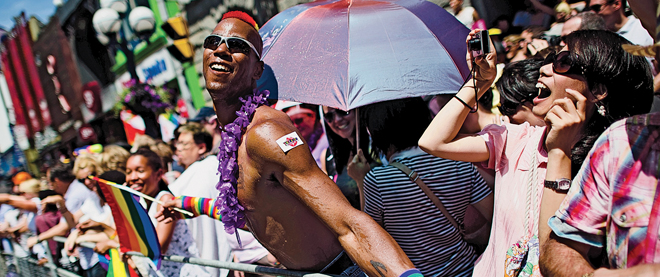Raining on the Pride parade
The Toronto event was widely reported to have been attended by a million people—an impossible statistic
Share

As far as estimates go, one million has a nice ring to it. Last week, a number of Toronto media outlets, including Macleans.ca, reported a dramatically inflated statistic: that one million people attended Toronto’s annual Pride parade on July 3. Maclean’s has since determined that this is both physically impossible, given the dimensions of the space, and highly improbable, given previous estimates of attendance. The number of attendees remains unconfirmed by Toronto police, the City of Toronto, and Pride Toronto organizers. So how did the media get it wrong? The erroneous news reports were a case of broken telephone that can be traced back to a 2009 estimate, which states that Pride week drew 1,120,000 visits. But visits, Maclean’s has learned, have little to do with attendance as we understand it.
Read the original online piece
“Attendance is a tricky word,” says Michael Harker, senior partner at Toronto-based Enigma Research Corporation, the research company behind the 2009 report. “There’s a big difference between visits and unique attendees. Visits is, a guy comes three times, we count him three times. Uniques is, he comes three times, we count him once.” That one million figure, then, accounts for total visits to the 2009 festival—multiple returns over the span of four days—and not for boots on the ground at the festival’s flagship parade. The total number of uniques was actually 411,450, which, again, does not represent just parade attendees but all visitors over the course of four days. Enigma did not provide an estimate for how many people were at the parade itself. In fact, no one did.
Const. Victor Kwong, media relations officer at the Toronto Police Service, explains that the police don’t give estimates anymore. “We used to do estimates, but we got a lot of complaints. People would say, ‘Oh, you’re lowballing so that the event gets less press,’ or, ‘You’re highballing so the event gets more support.’ ”
Maclean’s contacted reporters who cited the one million figure. Canadian Press, which determined that the estimate had been published without attribution, issued a correction a day later. Another outlet attributed the number to an estimate given out by Pride executive Francisco Alvarez. “Until the question was asked, I didn’t really understand the difference between unique attendees and visits,” says Alvarez, co-chair of the Toronto Pride board of directors. “We weren’t doing any audience estimates—we were using an educated guess based on what the result was in 2009, with a mix of people not really understanding what the term ‘visits’ means.” Whatever the estimate, Alvarez adds, business will be unaffected. “We really have no need to estimate the number. Our grants aren’t contingent on reaching a particular number—and neither are our sponsorships.”
Mark Glucki, a local resident who works in social media and marketing, spent Sunday amongst the revellers lining the streets for the parade. Glucki, 30, admits he was skeptical about the one million estimate. “I do Web analytics at work and there’s a difference between page views and unique page views. If you want to report the true value of your website, you report unique page views. If you want to inflate your numbers, you just report page views.” An apt analogy.
WATCH: Maclean’s staffers attempt to recreate one square metre of Pride parade
But surely Pride isn’t the only unticketed event that is touted to have a larger-than-life draw. Toronto’s Scotiabank Nuit Blanche—a 12-hour arts festival that runs from sunset to sunrise—states that nearly one million attended in 2010. That was a rough, outside estimate, a spokesperson explains. Based on research from Ipsos Reid, the event drew anywhere between 150,000 and 1.5 million people. Toronto’s Santa Claus Parade, which claims to be Toronto’s biggest parade, doesn’t give attendance estimates.
“Event promoters in general like to talk about the biggest number they can,” says Harker. “They might say it in an interview and then somebody, instead of calling it visits, calls it attendance, and the next person misinterprets it—this is at the root of a lot of the misunderstanding. Yeah, a million people down Yonge Street—that’s not going to fit.”
Million-person headlines could have consequences for taxpayers. Events like Pride are in part funded by public money, and inflated attendance numbers could skew the general perception of the event’s popularity and economic impact. A spokesperson for the City of Toronto, however, told Maclean’s that while many factors are at work in determining funding for events like Pride, including attendance, Pride submitted its research, where the difference between unique attendees and visits is plain to see. Not so plain for the rest of us, it seems.